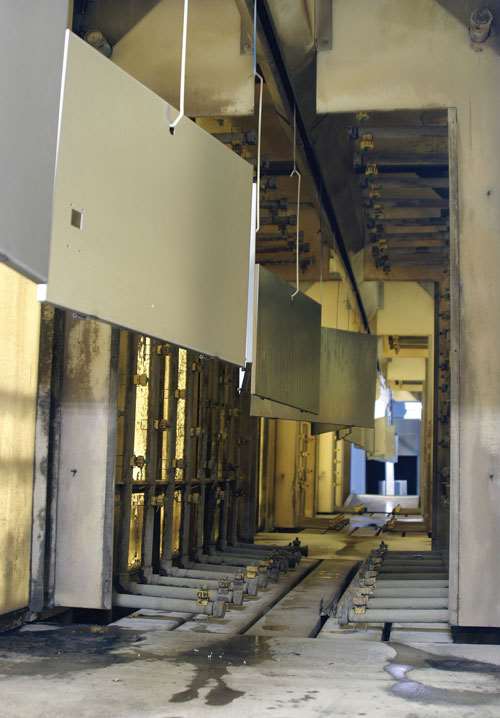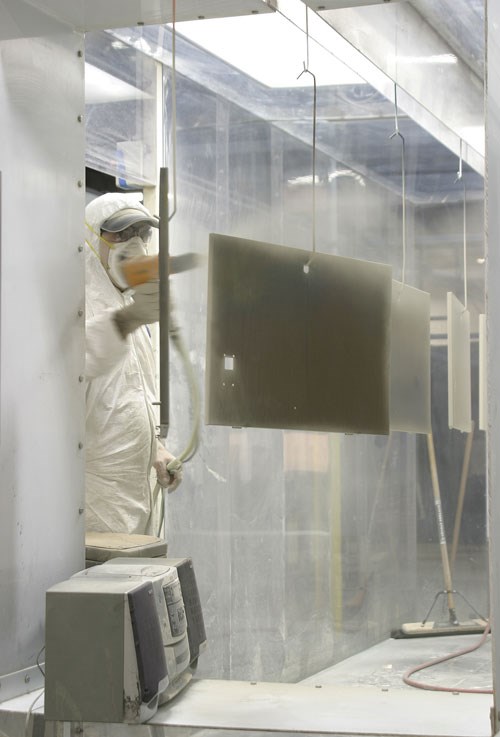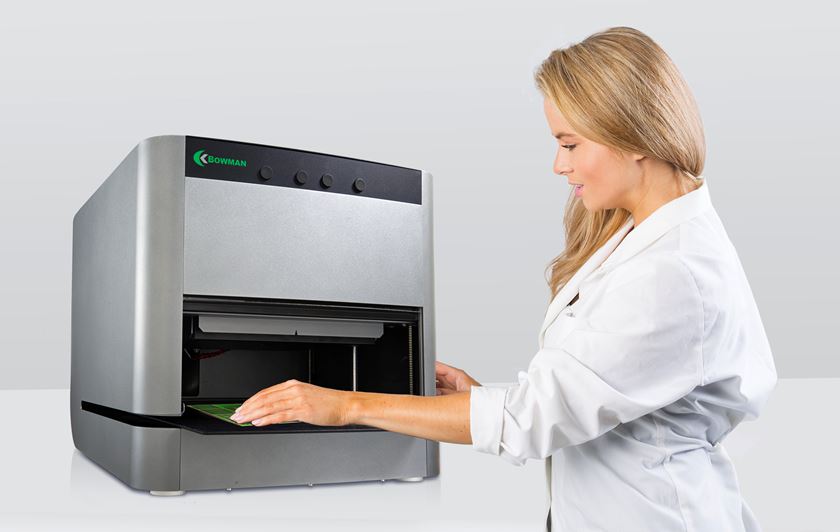Sheet metal fabricators and custom coaters—so alike in some ways, unlike in others—sometimes clash. Both juggle myriad orders of varying quantities and due dates, and both measure success on throughput: the more work they ship during a given period, the more revenue they can expect.
But challenges in the business relationship often arise because of how a fabricator’s customers now perceive inventory: they don’t want to carry it. Instead of ordering large lot sizes of 1,000 items, a fabricator’s customer now might order 50 at a time, want it delivered yesterday, and expect year-over-year price reductions, too.
To meet these challenges, fabricators have implemented elements of lean manufacturing and other improvement methods. They have had no choice but to produce short runs, which it turns out has actually made fabricators more productive.
To avoid excessive setup times, historically a fabricator’s machine operators ran large batch sizes and grouped like orders together, even if some orders weren’t due for weeks. This meant other orders waited until the operator finished the massive batch (or group of similar batches). This technique kept all machines running full out, so machine efficiency measurements were sky-high. Still, not as many orders shipped because so many components sat for days or weeks as work in progress, waiting for machine time and creating a shop-floor traffic jam.
Now it’s about quick turnaround and changeover between jobs. Only orders due immediately are fabricated; others aren’t released to the shop floor. Shop managers are careful to maintain excess capacity to absorb the variability, such as the unexpected hot job that’s just unavoidable in high-mix, low-volume operations. Yes, operators may spend more time setting up machines, but the parts traffic jam becomes unclogged. Fewer parts are in the system, but more are shipping to customers every day; which means, ultimately, more cash is coming in.
All this describes the transformation Phoenix Products Co. underwent. The Milwaukee-based maker of lighting components and electrode drying ovens is a classic example of a high-mix, low-volume manufacturer. The company fabricates, machines, and assembles more than 22,000 different products, and the number of SKUs just keeps growing.
In 2006 the shop adopted an improvement methodology called quick-response manufacturing (QRM), developed by Rajan Suri at the University of Wisconsin-Madison. The basics of it relate roughly to lean manufacturing, but are tailored for high-mix, low-volume work. The method champions processing small batch sizes and maintaining excess capacity buffers to absorb demand variability, so an operation can take on that unexpected hot job.
To implement QRM fully, though, Phoenix Products shop managers knew they needed to involve their suppliers, and this included its custom powder coater, B&K Powder Coating, located a few miles from the plant. At the time, B&K could turn around a job in eight to 10 days, which was acceptable when Phoenix worked with larger batches and longer customer lead times. Actual powder coating didn’t take terribly long, of course. What took time was waiting for a slot in the coating schedule.
After implementing QRM, though, Phoenix wanted to promise its customers delivery in days instead of weeks. Salespeople promoted the virtues of small, frequent orders, which allowed customers to lower their parts inventory levels. Customers could order just what they needed and have it delivered just in time. It also happened to improve part flow and lower inventory levels at Phoenix. It seemed like a win-win.
But what about the custom powder coater?
Quick-change Coating
Rodger Talbert can feel a custom coater’s pain. Executive director of The Woodlands, Texas-based Powder Coating Institute and longtime industry consultant, Talbert has set up and worked on many coating lines. He’s performed countless color changes and has analyzed typical powder coating challenges: racking design, masking, part density on the line, and so on.
Historically, the color change was an arduous affair. An operator would need to tear down a gun, take the hose part, and blow air over the interior and exterior of all components. He’d take one color module away and put another in its place. In the case of a cyclone system, he would clean the cyclone interior and the base receptacle. To reclaim the overspray, he would need to wipe or blow the booth walls.
“A reclaim-to-reclaim [color change] on a small or medium-sized system could take you 20 minutes,” Talbert says, adding that larger systems could take an hour or longer.
Just like their fabricator counterparts, powder coaters over the years have worked to shorten changeover times. In a manual application, a simple box-feed system instead of conventional feed hoppers can speed changeovers greatly.
“Instead of pouring the powder from the box into a container and adding air to stir it up and fluidize it, they would take the box itself, open it, put it on a vibratory tilt table, and drop a pickup tube straight into the box,” Talbert explains. “Now they don’t have a feed hopper to worry about. When they do a color change, they blow off the pickup tube, the pump, the hose, the gun barrel, and they switch boxes.
“It’s about a three- to five-minute process from one color to the next,” he says, adding that the process doesn’t involve overspray reclamation.
Talbert also says that some of today’s advanced color-change systems reduce color change to mere seconds rather than minutes. However, these systems usually make sense in product-line manufacturing environments that use only a limited number of colors, because such lines often require dedicated feed hoppers.
“What if you have to run 100 colors? Do you have 100 feed hoppers? It gets complicated,” he says.
The color-change situation often clashes with a fabricator’s need to respond quickly to its customer. Consider a fabricator whose customer hands him a hot order needed in a few days. When the parts are ready, the fabricator calls the custom coater.
As Talbert puts it: “That fabricator may say, ‘I know you’re in the middle of that two-hour black run, but I need you to stop it, and I need you to take those racks and those parts out of the way, and I need you to change your colors, and I need you to put my racks and my parts up--and I need them in an hour!’”
Say a changeover takes the shop 20 minutes. An extra three changeovers means the custom coater has lost an hour of production. “A revenue hour in a typical [custom coater] is worth anywhere from $500 to $1,000,” Talbert says. And it can be even more, depending on the operation.
In other words, if the line’s down, costs mount. And because fabricators themselves deal with annual price reductions from their customers, they in turn keep the pricing pressure on their suppliers. Color-change charges at many custom coaters, for example, have gone the way of the dodo.
To reduce cost, coaters maximize line utilization. They use strategic racking and, when at all possible, try to minimize empty hooks and line downtime. The higher the line density ‑ while still ensuring coverage‑ the greater the throughput. With greater throughput over less time, a custom coater can reduce costs and satisfy its customers’ demand for low prices.
Slicing Into the Schedule
Back at Phoenix Products, the conundrum was clear.
Phoenix’s improvement efforts hinged on producing many short runs extremely quickly—and each of those runs could require a different color. Such variable demand led to more color changes and, for the custom coater, more cost.
As Jamie Kaufmann, owner of B&K Powder Coating, Phoenix’s coating provider, puts it, “To go from a mindset of trying to keep your price down to trying to turn things very quickly, they work against each other for the customer and for the powder coater.”
In 2006 this problem gave managers at both companies a starting point. How can a high-mix, low-volume fabricator work with a custom coater so that both parties come out ahead? The companies collaborated with students from the University of Wisconsin-Madison’s Center for Quick Response Manufacturing, and one student suggested an intriguing idea: time slicing. In essence, the concept involves buying time instead of services rendered. Suri, who developed the QRM method, describes it this way in his book, It’s About Time.
“Essentially, you are purchasing slices of time at the supplier’s operation to support your operation. Of course there is a trade-off here—if you reserve capacity but don’t use it, you may have to pay the supplier an agreed-upon amount anyway. But this should be countered by the benefits obtained most of the other times, when you get your parts quickly.”
In theory, the concept could give both powder coater and fabricator exactly what each wants. The fabricator gains control over production, and the powder coater receives consistent payment. Sometimes that payment may not cover the cost of running a line; other times that payment is all gravy, because the fabricator may not need any parts coated at all.
Although this method no doubt could work very well for some, managers at both Phoenix and B&K saw some pitfalls for their situation. Say Phoenix buys several hours every Thursday afternoon at B&K; this means Phoenix can run its parts only once a week, but many customers just can’t wait that long.
Ultimately, Phoenix and B&K tweaked the idea of time slicing. Phoenix does not buy time, and it’s still charged for the parts it has coated. But thanks to continual communication between the two firms, B&K is able to “slice” a short run from Phoenix into runs from other customers, or prepare for a certain color to arrive on certain dates. You could almost call it “collaborative scheduling.” The arrangement ensures Phoenix gets its parts quickly and that B&K maintains the line uptimes it needs to keep prices low.
“I think we tweaked [time slicing] by just having the really good dialogue between the two companies on what our production schedules are and what they’re running,” says Jeff Konkel, Phoenix’s vice president of operations.
Don Goetzel, Phoenix’s scheduler, adds, “For instance, I know we have a basic yellow for dock lights and ovens, and I know that our fabrication people are working on that product and sending it out to paint. So I try to give [Conrad Johnson, B&K’s general manager] a day or two heads-up, saying, ‘I will have a truckload of yellow coming; when can you slice it in?’”
B&K has invested in people and equipment, including a new batch oven, and this certainly helped speed response. But the simple, nontechnical act of communication was the most significant contributor. Today the average powder coat lead time has been shortened from 10 days to three. And some jobs are turned around even faster.
Challenges and Benefits
Many metal fabricators bring finishing in-house quite successfully. The process is one of the last to occur before shipping, so it can make business sense to install a line to gain more control over the manufacturing schedule, not to mention offer more services to customers.
Making it work, though, requires significant forethought.
“There’s a whole new game to learn,” Talbert says. “They need to inventory the powder, the racks, the tooling, masking; they need to hire someone who knows how to run a washer and measure chemistries. [A fabricator’s] reason for integrating often is to gain better control over their demand, and that almost naturally carries with it a reduction in efficiencies. So chances are pretty good their costs will look ugly at some levels.”
He adds that the fabricator may not look at unexpected color changeover like a custom coater does. A custom coater sees it as dollars lost from excessive downtime; a fabricator simply sees it as the reason that it invested in a coat line in the first place.
If a fabricator invests in a coating line and it increases throughput, and if the shop can sell the extra capacity the powder coat line has opened up, a fabricator can achieve a good return on investment.
Vivek Gupta knows how challenging powder coating can be. Typically, a fabricator brings powder coating in-house, but Gupta’s father reversed the process: He launched a finishing company called Image Industries in 1985, then in 2000 launched Texas ProFab Corp., a sheet metal fabricator. Both companies share a building in Carrollton, Texas, near Dallas.
Gupta, managing director of Texas ProFab, explains that solving a problem in powder coating can be far more expensive than preventing the problem in fabrication. This fact does, however, reveal significant advantages for companies having both fabrication and powder coating under one roof.
“A lot of fabricators start a finishing shop, and they take for granted a lot of the nuances and complexities related to the process,” Gupta says. “It just becomes another cost center—something they can internalize, and save on all those checks they’ve been writing to painters. But it’s a lot more than just buying equipment. But by going the other way, we focused on fabrication from a finishing perspective. We thought about certain [fabrication operations] that would make life easier for the finisher.”
For example, certain parts may require a Class A finish, one with few defects and very consistent color and gloss. To achieve such a finish, a company with both fabrication and finishing can tweak processes upstream to ensure the final painting process can produce the best finish possible. As Gupta explains, this may involve perfecting a flat-part deburring process, a hand grinding process, or perhaps changes to a hardware insertion procedure. It also can involve some fixture designs that can streamline masking.
Consider a component requiring hidden standoff hardware that can’t be visible from the other side of the part.
“If you press them in a little bit harder, then perhaps use a finer grit to deburr it, then you may not have to do that much with the painting process,” Gupta says. “But if the part is not deburred properly, or if the part requires some grinding, sanding, or maybe some Bondo fill to make the part have a truly Class A finish—for which those stud heads need to be concealed—it can be a challenge.”
A fabricator with in-house painting could perform more expansive design-for-manufacturability work (or at least suggest small changes to its customer) to make the coating process easier.
As Talbert explains, “Coating can sometimes be very difficult if the shape of the part doesn’t [allow the finish] to drain very well, there’s no place to make a good hanging contact, or there are areas that may be difficult to get adequate coverage.” Having both finishing and fabrication in-house may help spur such DFM.
But could the same DFM discussions occur between a fabricator and custom coater? Phoenix’s Konkel chuckles. The company has had those discussions, he says, and “B&K has been great in giving us direction on where to put holes for part hanging.” But he admits that “we probably don’t do enough with DFM.”
Outsource or Not?
For Phoenix Products, staying in the metal manufacturing sandbox and outsourcing the coating has worked extremely well. The company effectively cut its coating lead time by more than half without having to invest in machines or people. On the other hand, numerous fabricators—especially in the job shop arena—have entered the finishing business with great success, expanding their offerings and making it easier to get into new markets, thereby diversifying their customer bases.
As with anything in business, the decision whether to invest in equipment or outsource coating depends on the local market, the custom coaters available and customer demands. But whatever the decision, communication is essential. People need to know the process to ask the right questions—about paint coverage, racking, masking, color-change technique, parts washing, oven operation, part hanging, line density, and so on.
In a sense, a finishing line—be it at a custom coater or a fabricator—is only as good as the knowledgeable people running it. n
For more inforamtion, please contact:
B&K Powder Coating, 414-353-4410, bnkpowder.com
Center for Quick Response Manufacturing, University of Wisconsin-Madison, 608-262-4709, qrmcenter.org
Image Industries, 972-241-5200, www.image-industries.com
Powder Coating Institute, 832-585-0770, powdercoating.org
Phoenix Products Co. Inc., 414-973-3300, phoenixproducts.com
Texas ProFab Corp., 972-241-5050, texasprofab.com
RELATED CONTENT
-
In these uncertain times, it is refreshing to hear from and learn about young talent in the surface finishing industry who are striving to make a difference within their organizations and the industry as a whole.
-
John Cole of powder coating equipment supplier Parker Ionics discusses how to get a worthwhile return on your investment in employee training.
-
Technical Plating was recently named a Products Finishing Top Shop. We spoke with shop manager and vice president (and 40-Under-40 member) Tyler Thomas to learn more about how the shop runs.

















